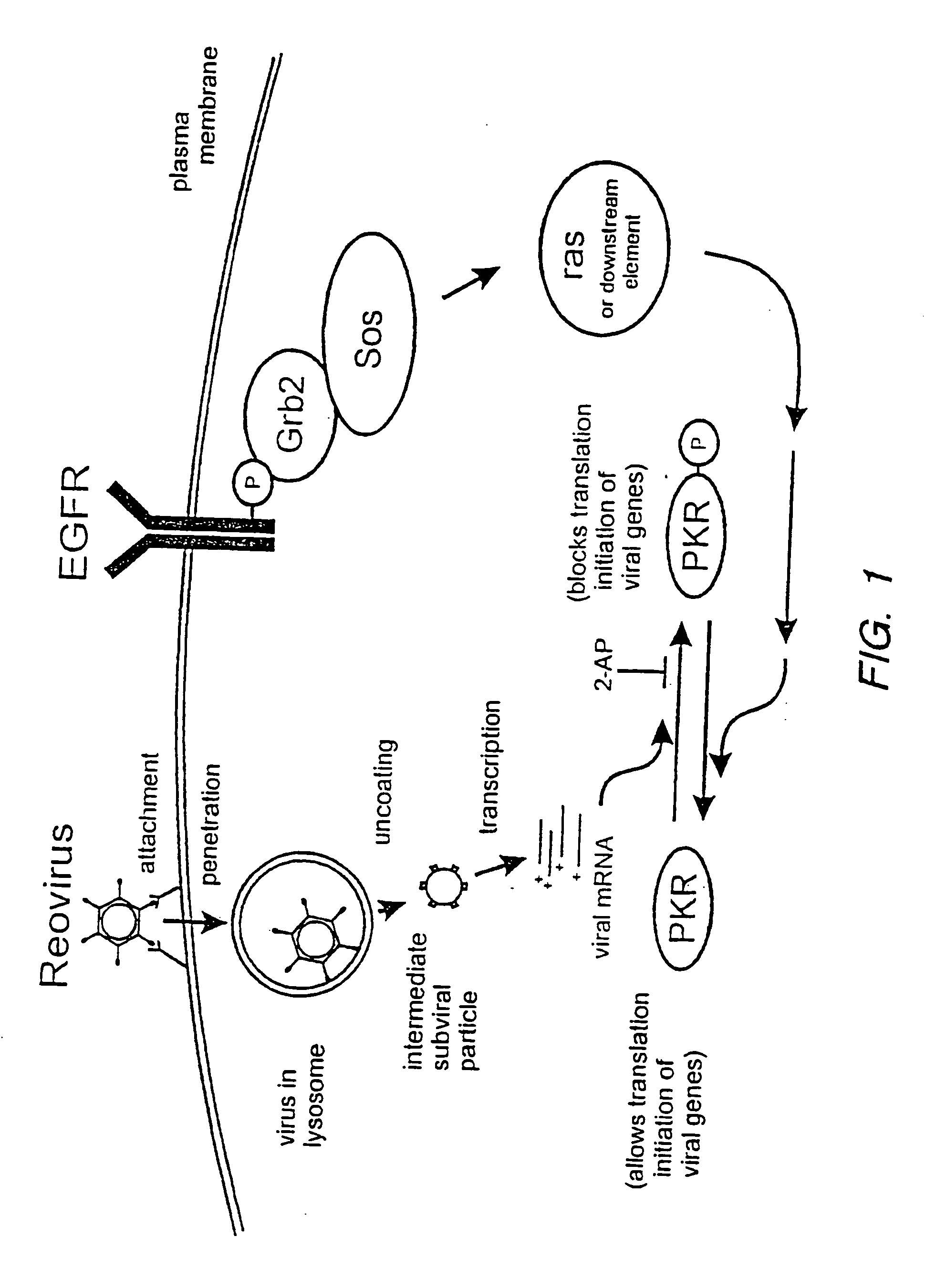Reovirus for the treatment of cellular proliferative disorders
a proliferative disorder and cellular technology, applied in the field of rasmediated proliferative disorders in mammals, can solve the problems of preventing complete cure of cancer, many tumors cannot be completely removed by surgical means, and neoplastic growth (neoplasia), and achieve the effect of suppressing tumor growth
- Summary
- Abstract
- Description
- Claims
- Application Information
AI Technical Summary
Problems solved by technology
Method used
Image
Examples
example 1
Activated Intermediates in the Ras Signalling Pathway Augment Reovirus Infection Efficiency
It was previously shown that 3T3 cells and their derivatives lacking epidermal growth factor receptors (EGFR) are poorly infectible by reovirus, whereas the same cells transformed with either EGFR or v-erb B are highly susceptible as determined by cytopathic effects, viral protein synthesis, and virus output (Strong, J. E. et al.,(1993) Virology, 197:405-411; Strong, J. E. and Lee, P. W. K., (1996) J. Virol., 70:612-616).
To determine whether downstream mediators of the EGFR signal transduction pathway may be involved, a number of different NIH 3T3-derived, transformed with constitutively activated oncogenes downstream of the EGFR, were assayed for relative susceptibility to reovirus infection. Of particular interest were intermediates in the ras signalling pathway (reviewed by Barbacid, M., Annu. Rev. Biochem., 56:779-827 (1987); Cahill, M. A., et al., Curr. Biol., 6:16-19 (1996). To inves...
example 2
Enhanced Infectibility Conferred by Activated Oncogenes is Not Due to Long-term Transformation or the Generalized Transformed State of the Cell
To determine whether the differences in susceptibility may be the result of long-term effects of transformation, or the result of the activated oncogene itself, a cell line expressing a zinc-inducible cellular Harvey-ras (c-H-ras) gene was tested for susceptibility to reovirus infectibility, as described above. These cells, called 2H1, were derived from the C3H 10T½ cell line which is poorly infectible by reovirus (data not shown), and carry the c-H-ras gene under the control of the mouse metallothionine-I promoter (Trimble, W. S. et al. (1986) Nature, 321:782-784).
Cells were either mock-treated or pretreated with 50 μM ZnSO4 18 hours prior to infection or mock-infection (administration of carrier agent), followed by indirect immunofluorescent analysis of these cells at 48 hours postinfection or mock-infection.
The results (not shown) de...
example 3
Viral Transcripts are Generated but Not Translated in Reovirus-Resistant NIH 3T3 Cells
The step at which reovirus infection is blocked in nonsusceptible NIH 3T3 cells was also identified. Because virus binding and virus internalization for nonsusceptible cells were comparable to those observed for susceptible cells Strong, J. E. et al., (1993) Virology, 197:405-411), the transcription of viral genes as investigated.
The relative amounts of reovirus S1 transcripts generated in NIH 3T3 cells and the Ras-transformed cells during the first 12 hours of infection were compared after amplification of these transcripts by polymerase chain reaction (PCR), as described above. The results demonstrated that the rates of accumulation of S1 transcripts in the two cell lines were similar, at least up to 12 hours postinfection.
Similar data were obtained when rates of accumulation of other reovirus transcripts were compared (data not shown). These results demonstrate that infection block in nons...
PUM
| Property | Measurement | Unit |
|---|---|---|
| diameter | aaaaa | aaaaa |
| pharmaceutical composition | aaaaa | aaaaa |
| resistance | aaaaa | aaaaa |
Abstract
Description
Claims
Application Information
 Login to View More
Login to View More - R&D
- Intellectual Property
- Life Sciences
- Materials
- Tech Scout
- Unparalleled Data Quality
- Higher Quality Content
- 60% Fewer Hallucinations
Browse by: Latest US Patents, China's latest patents, Technical Efficacy Thesaurus, Application Domain, Technology Topic, Popular Technical Reports.
© 2025 PatSnap. All rights reserved.Legal|Privacy policy|Modern Slavery Act Transparency Statement|Sitemap|About US| Contact US: help@patsnap.com



